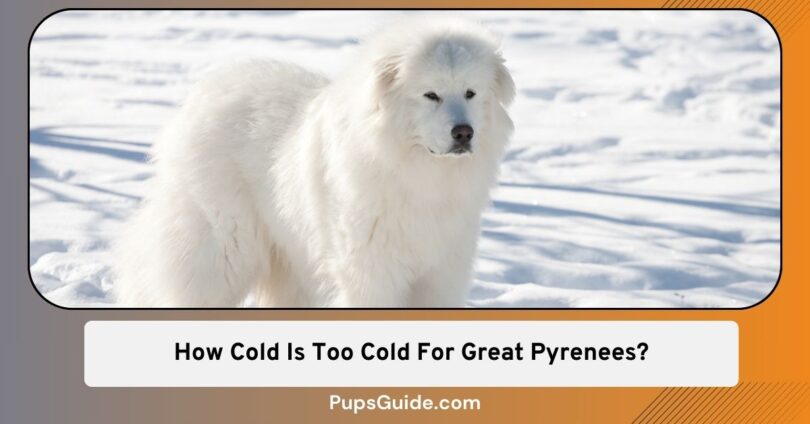Winter is the time when frosty winds make us bundle up like walking marshmallows. But what about our pets, particularly those majestic Great Pyrenees with their luxurious double coats and regal looks? Just how cold is too cold for them as apparently, they are snow-loving giants?
Let’s dig into the frigid details and ensure our gentle giants stay cozy through winter’s icy grip.
How Cold Can Great Pyrenees Tolerate?
Your Pyrenees, a majestic ball of fluff, may stand tall in the midst of a winter wonderland. But as the mercury drops, how do you know when the cold becomes too much for your canine companion?
Pyrs, being mountain dogs bred to guard flocks in the Pyrenees Mountains, have a natural affinity for chilly weather. However, they have their limits.
As a rule of paw, the furballs can comfortably handle temperatures as low as 0°F to -10°F (-17°C to -23°C). I’ve seen owners leave them outside on as low as -20°C and check on them periodically.
Their thick double coat, designed by nature itself, acts as a built-in insulation system, protecting them from the biting cold. It’s like having a personal, permanent snuggly blanket!
Temperature Tolerance Rooted in Breed History
To truly grasp the Great Pyrenees’ cold weather endurance, let’s take a brief journey back to their roots.
Originating in the Pyrenees Mountains between France and Spain, these dogs have centuries of experience with harsh, wintry conditions. Their ancestors braved freezing temperatures while diligently guarding livestock in the rugged terrains.
This historical perspective is crucial for understanding why the Great Pyrenees are better equipped to handle the cold than your average pooch. They know a thing or two about staying warm!
Signs that Your Dog Might Be Feeling the Chill
While this breed is a winter warrior, there are still signals that indicate your fur buddy might be on the brink of catching a cold. Keep a keen eye out for shivering, lethargy, and a reluctance to go outside.
If your dog starts lifting its paws or favoring one leg over the other, it’s time to take action. These subtle cues can be your canine’s way of saying, “Hey, it’s getting a bit nippy out here!”
Beyond the Bearable: When to Worry and What to Do
So, you’ve checked the forecast, and the temperatures are plummeting to levels even a Siberian Husky might hesitate to face.
What now? Fear not, dear dog parent, for there are steps you can take to ensure your Great Pyrenees remains snug as a bug in a rug even when the weather turns frosty.
Cozy Shelter is a Must-Have:
When the chill is too much to bear, ensure your dog have a warm and sheltered haven. A well-insulated doghouse with ample straw or blankets provides a retreat from the biting cold.
Layer Up the Love:
Yes, your Great Pyrenees has that luxurious double coat, but a little extra layering won’t hurt, especially during extreme cold spells. Consider investing in canine-friendly sweaters or jackets to add an extra shield against the frosty winds.
Paws Need Protection Too:
Just like our toes, a dog’s paws are susceptible to frostbite. Booties or paw wax can be a game-changer, offering protection against cold surfaces and harmful ice-melting chemicals.
Hydration Matters:
Cold weather doesn’t diminish the importance of hydration. Make sure your dog has access to unfrozen water. A hydrated dog is a happy and healthy dog, even in the snow.
Exercise with Caution:
I agree that the Great Pyrenees have an adventurous spirit, but it’s still crucial to be mindful of their activity levels in extreme cold. Opt for shorter, more frequent walks, and pay attention to any signs of discomfort.
You know that prevention is the best medicine. By taking these steps, you’re not just shielding your dog from the cold – you’re ensuring they can continue to romp in the snow with boundless joy.
In Conclusion: How Cold Is Too Cold for Great Pyrenees?
During the chilly months, let’s keep in mind that your Great Pyrenees are part of the family. Keep their cold weather tolerance in mind, all the while respecting their breed history, and recognizing subtle signs of discomfort are the keys to keeping them safe and snug.
In doing so, whether it’s a gentle snowfall or a full-blown blizzard, your majestic dog will be ready to face the cold with tails held high and fur fluffed to perfection.
Winter may be frosty, but with a little extra care, your dog can enjoy the season as much as we do. Stay warm, stay safe, and let the snowy adventures begin!








Leave a Comment